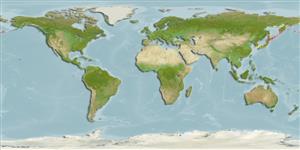>
Perciformes/Zoarcoidei (Eelpouts and pricklebacks) >
Neozoarcidae ("Largemouth kissing eelpouts")
Etymology: Neozoarces: Greek, neos = new + Greek, zoarkes = that gives life (Ref. 45335).
Eponymy: Franz Steindachner (1834–1919) was an Austrian zoologist who specialised in herpetology and ichthyology. [...] (Ref. 128868), visit book page.
More on authors: Jordan & Snyder.
Issue
Neozoarces steindachneri may be a synonym of Neozoarces pulcher (Ref. 51666).
Environment: milieu / climate zone / depth range / distribution range
Sinh thái học
Biển gần đáy; Mức độ sâu 0 - 10 m (Ref. 56557). Temperate
Northwest Pacific: Okhotsk Sea off Sakhalin and Hokkaido, Pacific coast of Hokkaido, Japan Sea off Russian coast from Tatar Strait to Peter the Great Bay and off Japan northward from Aomori Prefecture.
Bộ gần gũi / Khối lượng (Trọng lượng) / Age
Maturity: Lm ? range ? - ? cm
Max length : 11.0 cm TL con đực/không giới tính; (Ref. 56527)
Inhabits seaweed areas along the coast.
Life cycle and mating behavior
Chín muồi sinh dục | Sự tái sinh sản | Đẻ trứng | Các trứng | Sự sinh sản | Ấu trùng
Masuda, H., K. Amaoka, C. Araga, T. Uyeno and T. Yoshino, 1984. The fishes of the Japanese Archipelago. Vol. 1. Tokai University Press, Tokyo, Japan. 437 p. (text). (Ref. 559)
IUCN Red List Status (Ref. 130435: Version 2024-2)
Threat to humans
Harmless
Human uses
Các công cụ
Special reports
Download XML
Các nguồn internet
Estimates based on models
Preferred temperature (Ref.
123201): 3.8 - 17, mean 6.2 °C (based on 302 cells).
Phylogenetic diversity index (Ref.
82804): PD
50 = 0.7500 [Uniqueness, from 0.5 = low to 2.0 = high].
Bayesian length-weight: a=0.00389 (0.00180 - 0.00842), b=3.12 (2.94 - 3.30), in cm total length, based on all LWR estimates for this body shape (Ref.
93245).
Mức dinh dưỡng (Ref.
69278): 3.2 ±0.5 se; based on size and trophs of closest relatives
Fishing Vulnerability (Ref.
59153): Low vulnerability (10 of 100).
